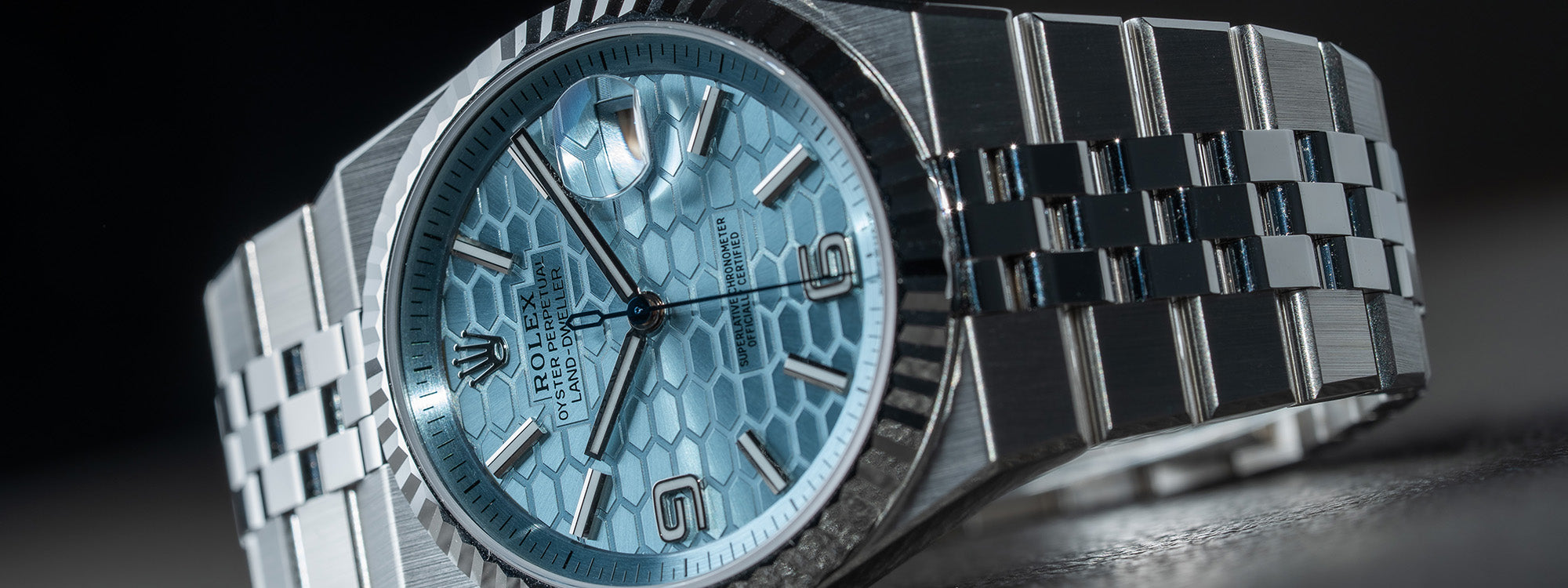Rolex has made many lasting contributions to the world of watchmaking since its foundation in 1905, not the least of which has been an array of massively popular and widely emulated bracelet designs. Here we take a close look at every type of Rolex bracelet, what makes it special, and which Rolex watches, if any, are using them today.
Rolex Oyster Bracelet

Rolex’s iconic Oyster bracelet is the template from which many other three-link bracelet styles have been drawn. Its name comes from its association with the Oyster case — introduced by Rolex founder Hans Wilsdorf in 1926, and the most water-resistant watch case that had been made up to that point — and for which the original version of this bracelet served as an extension. Oyster bracelets are recognizable for their wide center links bordered by thinner end-links. Rolex patented the design in 1947 and fitted one on a watch in 1948. In the early versions, the links were riveted; these were phased out in favor of a “folding” style in 1967, which eventually gave way to the modern, solid-link style in 1975. Oyster bracelets come equipped with the accompanying Oysterlock clasp, a triple-deployant metal clasp with a safety-lock mechanism.

Three-link bracelets like the Oyster and its various descendants are particularly popular on sports watches and dive watches, and this bracelet appears, as you’d expect on most of Rolex’s most popular “professional” models, including the Submariner, GMT-Master II, Explorer, and Daytona.
Rolex President Bracelet

The Rolex Day-Date appeared on the market in 1956 and with it came a new three-link bracelet called the President. Intended as the epitome of Rolex’s luxurious bracelet options, and initially made only in precious metals, its links are semicircular-shaped, with wider links on the center and thinner ones on the edges. The President bracelet remains almost exclusively the property of the Day-Date models (which, not coincidentally, are also nicknamed “President”), though they are also found on some Datejust and Lady Datejust models.

The bracelet, in fact, was named before the watch, signaling that the Crown had always hoped to market the Day-Date as a favorite watch of chief executives and other powerful figures. Another key aesthetic aspect of the President bracelet is its use of a concealed “Crownclasp,” a discreet closure operated by a small lever in the shape of Rolex’s renowned crown logo to lock and release the bracelet without interrupting the flow of its design.
Rolex Jubilee Bracelet

While it’s not as ubiquitous as the Oyster bracelet, the Jubilee was actually the first bracelet style that Rolex made in-house. Renowned for its five-link design, with three rows of smaller center links flanked by two rows of larger links on each side, it made its debut on the watch for which it was specifically designed, the first Rolex Datejust, in 1945. At the time, the Jubilee, still considered one of Rolex’s dressiest and most luxurious bracelet options, was offered only in solid gold; today the brand makes it in various metals and bi-metal iterations. This was partly due to the Jubilee’s eventual adoption by sportier models like the GMT-Master as well as the elegant Datejust, after the introduction of the President bracelet (see above).

Over the years, the link styles and shapes have subtly changed, from folded to D-shaped to oval-shaped to solid. Since there are more individual links in this type of bracelet, it tends to be a little more form fitting than the three-link Oyster, though the latter is generally thought of as more robust since the links themselves are larger. Jubilee bracelets fasten with either the concealed Rolex Crownclasp or the more prominent, more flexible Oysterclasp. Among the current Rolex models that offer the Jubilee bracelet is an option, the newest is the Land-Dweller, which debuted in 2025.
Rolex Oysterflex Bracelet

Dating back only to 2015, and thus far still exclusive to Rolex and not emulated by any other brand, is the Oysterflex bracelet, which many observers might prefer to categorize as a strap because of its black rubber exterior. However, the Oysterflex, which made its debut on the first Rolex GMT-Master model in Everose Gold, is actually much more complex in construction than an initial glance would reveal. Its interior houses a patented “longitudinal cushion” system, composed of titanium and nickel-alloy blades wrapped inside black elastomer, which gives the Oysterflex the rigidity and stability of a metal bracelet while still offering the softness and suppleness of a strap.

The Oysterflex is still rather a niche option compared to Rolex’s longer-established bracelets, but it is now available on several Oyster Perpetual sport-luxury models in the collection, including the Yacht-Master, Sky-Dweller, and even some versions of the Daytona.
Rolex Pearlmaster Bracelet

The rarest Rolex bracelet on our list traces its origin to 1992 and shares its name with the watch model on which it debuted. Design-wise, the Rolex Pearlmaster watch, which was only recently discontinued in 1992 after three rather quiet decades on the market, is clearly descended from the Datejust, but distinguished from that model (and other classic Rolex models) by its use of exclusively precious metals for the cases and bracelets and the presence of at least 12 diamonds or gemstones on all versions of the watch. Positioned as a higher-end Lady Datejust, the Pearlmaster featured a bracelet composed of interlocking rows of five rounded links. Initially only found on the Lady Datejust editions, this style of bracelet migrated to a series of Datejust “Masterpiece” models in the 2000s, catching the attention of male audiences. It’s still winning over fans like Drake, Kylie Jenner, and Chris Tucker, despite being discontinued.
Rolex Settimo Bracelet

The most recent Rolex bracelet option fittingly made its debut on the most recently introduced Rolex watch model, the dressy, vintage-inspired Perpetual 1908, which had previously been available only on leather straps. The newly developed Settimo bracelet, which made its debut on the 2025 edition of the Perpetual 1908, features gold links made from very small contoured link elements with polishing on all their surfaces. Together, these links hug the wrist and, perhaps even more notably, fasten with a new version of Rolex’s concealed, folding Crownclasp system, for which a patent has been filed.

This distinctive bracelet design, Rolex says, has been exclusively created for the Perpetual 1908 model; whether it will migrate, like its ancestor the Jubilee, to other Rolex families and models is a question for the future, but for now it is an element that further helps refine the distinctive identity of the historically rooted collection. You can learn more about all the Rolex bracelet types at rolex.com

























































0 Comments